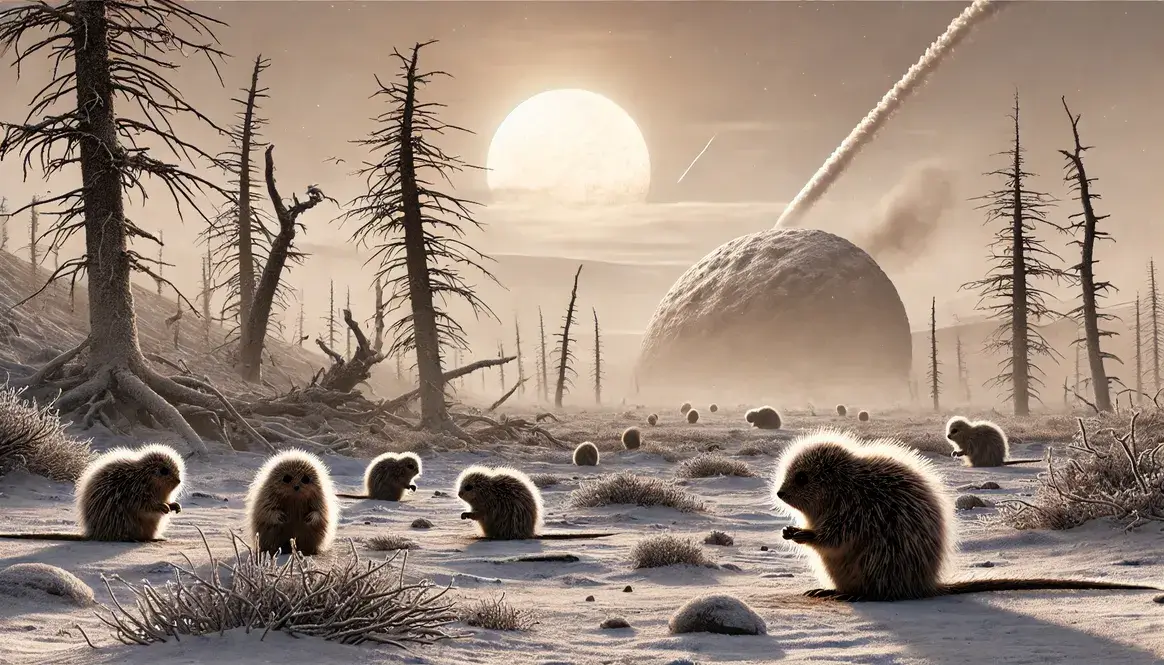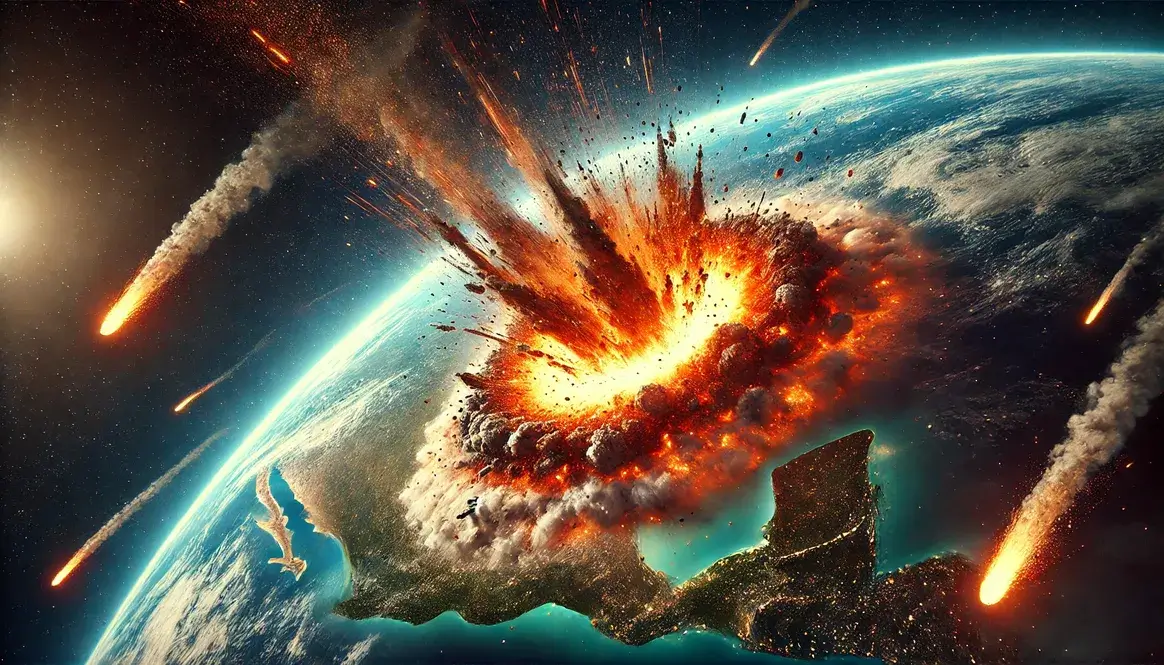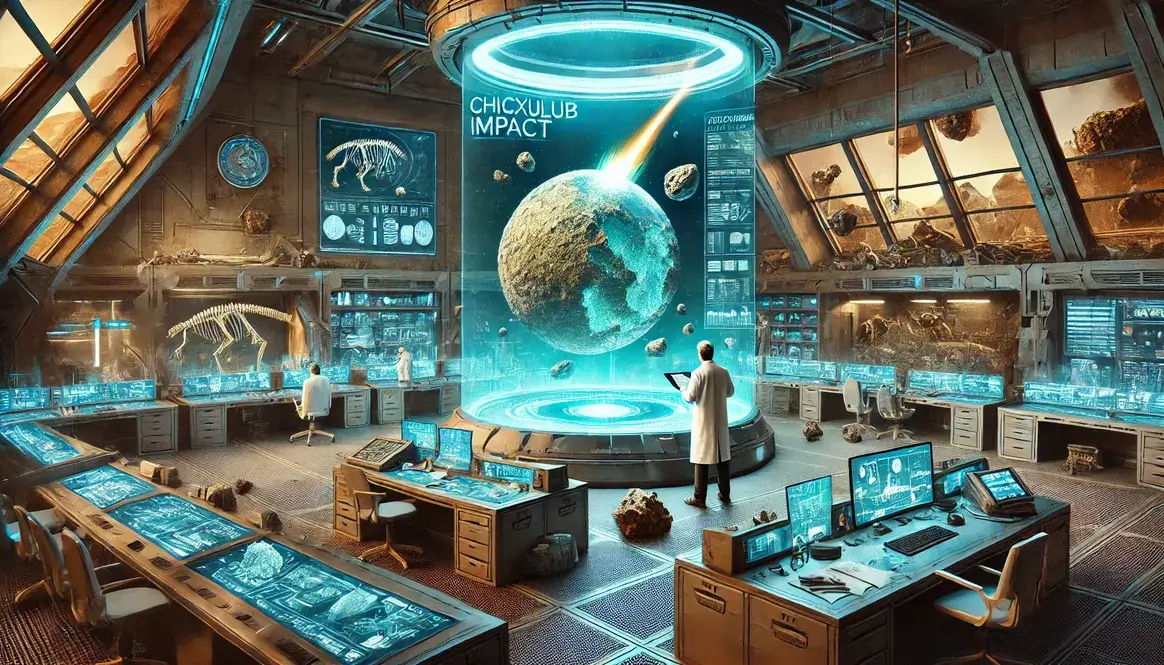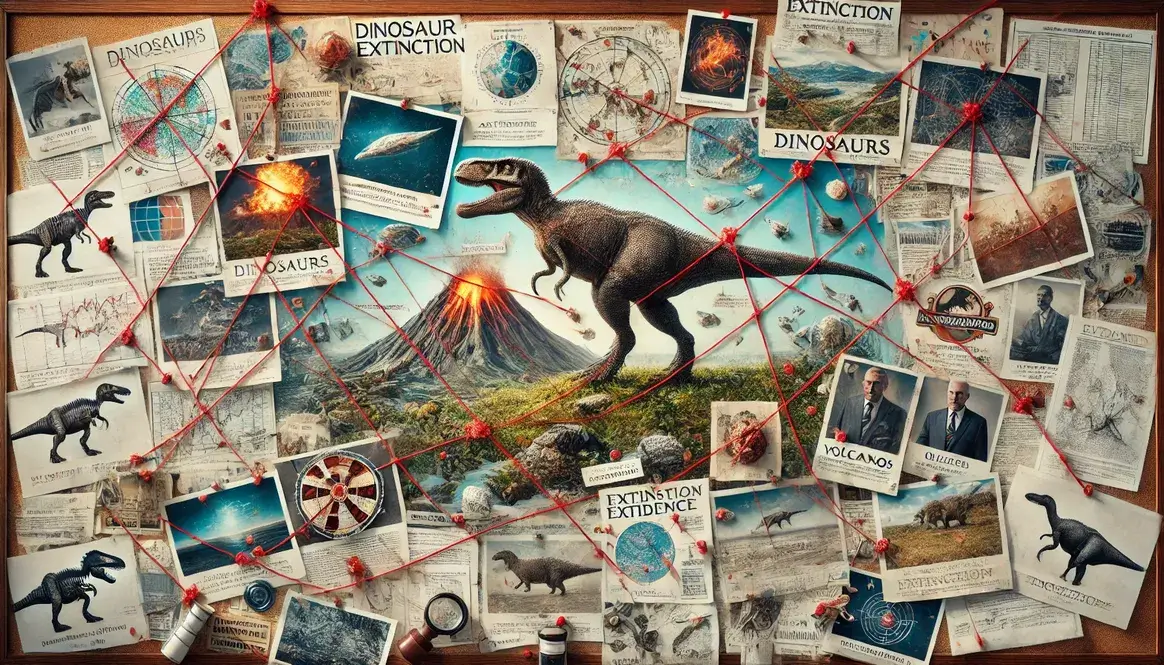When we think about the end of the dinosaurs, we often picture a fiery asteroid impact. But what followed was equally dramatic: an ice age after dinosaur extinction that reshaped our planet. This chilling chapter in Earth’s history plunged the world into a deep freeze, challenging the survivors of the cosmic catastrophe with a new set of obstacles.
In this article, we’ll explore how our planet transformed from a warm, lush world to a frozen landscape. We’ll uncover the evidence for this dramatic cooling, examine its effects on life, and see how Earth eventually thawed out.
The Immediate Aftermath of the K-Pg Impact
When the massive asteroid slammed into Earth about 66 million years ago, it kicked off a chain of events that would forever change our planet. This cosmic collision, known as the K-Pg impact, not only wiped out the non-avian dinosaurs but also triggered a period of intense global cooling. Let’s explore how this catastrophic event plunged Earth into an unexpected ice age.
Initial Temperature Drop
Right after the impact, Earth experienced a rapid and severe temperature decline. Here’s what happened:
- The asteroid released an enormous amount of energy upon impact.
- This energy vaporized rocks and released massive amounts of heat.
- Surprisingly, this initial heat quickly gave way to a dramatic cooling effect.
Scientists estimate that within just a few days, global temperatures plummeted by as much as 20-30 degrees Celsius (36-54 degrees Fahrenheit). That’s like going from a warm summer day to below freezing in the blink of an eye!
Why did this happen? The answer lies in what the impact sent into our atmosphere.
Dust and Aerosols in the Atmosphere
The K-Pg impact threw an enormous amount of debris into the air. This debris included:
- Dust particles from pulverized rock
- Soot from global wildfires
- Sulfur aerosols from vaporized rocks
All these particles and gases formed a thick blanket in Earth’s atmosphere. This atmospheric blanket had a major effect on our planet’s climate:
- It blocked sunlight from reaching Earth’s surface.
- Less sunlight meant less heat could warm the planet.
- The result? A rapid and severe global cooling.
This phenomenon is similar to what happens after large volcanic eruptions, but on a much bigger scale. The amount of debris was so massive that scientists think it might have blocked up to 50% of the sun’s energy for several years!
| Time After Impact | Estimated Temperature Drop | Sunlight Blockage |
|---|---|---|
| 1 week | 20-30°C (36-54°F) | Up to 80% |
| 1 year | 10-15°C (18-27°F) | 50-60% |
| 5 years | 5-10°C (9-18°F) | 20-30% |
This sudden shift from the warm, mild climate of the late Cretaceous to freezing conditions marked the beginning of a long period of global cooling. As we’ll see in the next section, this cooling wasn’t just a short-term effect – it developed into a full-blown ice age that would last for thousands of years.
The Onset of the Post-Impact Ice Age After Dinosaur Extinction
As the dust began to settle from the K-Pg asteroid impact, Earth’s climate continued to change. The initial temperature drop was just the beginning of a long-term cooling trend that would reshape the planet’s ecosystems.
Evidence for Prolonged Cooling
Scientists have uncovered numerous clues that point to an extended period of cooling after the asteroid impact. These pieces of evidence come from various sources:
- Ocean Sediments: Tiny fossils found in deep-sea cores show a shift in the types of organisms living in the oceans. Cold-water species became more common, indicating a cooler climate.
- Plant Fossils: The types of plants that grew changed dramatically. Fossils show a decline in tropical plants and an increase in cold-tolerant species.
- Ice Cores: While we don’t have ice cores from this exact time, scientists use similar evidence from more recent ice ages to understand past climate changes.
- Geological Formations: Features like glacial deposits and frost wedges suggest colder conditions persisted for thousands of years.
One fascinating piece of evidence comes from analyzing oxygen isotopes in fossil shells. These tiny time capsules reveal that ocean temperatures dropped by about 7°C (12.6°F) and stayed cool for thousands of years after the impact.
Global Temperature Decline
The extent of global cooling during this post-impact ice age was significant. While it didn’t reach the extremes of the initial temperature drop, the long-term effects were profound.
Scientists estimate that average global temperatures fell by about 5-10°C (9-18°F) compared to pre-impact levels. This might not sound like much, but even small changes in average temperature can have big effects on climate.
To put this in perspective, consider this:
| Time Period | Average Global Temperature | Comparison to Today |
|---|---|---|
| Pre-impact | ~22°C (72°F) | +7°C (12.6°F) warmer |
| Post-impact | ~15°C (59°F) | Same as today |
| Ice Age Peak | ~12°C (54°F) | -3°C (5.4°F) cooler |
This cooling had far-reaching effects. Ice sheets expanded, sea levels dropped, and many species struggled to survive in the new, colder world. The once-lush landscapes of the late Cretaceous were transformed into a much colder and less hospitable environment.
As we’ll see in the next section, this dramatic cooling reached its peak during what scientists call the post-extinction ice age, reshaping life on Earth in ways that would echo through millions of years of evolution.
Peak of the Post-Extinction Ice Age
As Earth continued to cool following the asteroid impact, it entered a period of extreme cold unlike anything seen in millions of years. This was the pinnacle of the post-extinction ice age, a time when our planet looked very different from the warm, lush world of the late Cretaceous.
Maximum Extent of Ice Coverage
During this frigid phase, ice sheets and glaciers expanded dramatically, covering vast areas of the Earth’s surface. Here’s what the world looked like at the peak of this icy period:
- Polar Regions: Ice caps at both poles grew significantly larger than they are today.
- North America: Glaciers covered much of Canada and the northern United States.
- Europe: Ice sheets extended across Scandinavia and northern Europe.
- Asia: Large parts of Siberia were under ice.
- Southern Hemisphere: Ice expanded in Antarctica and parts of South America.
The growth of these ice sheets had a profound impact on sea levels. As more water became locked up in ice, global sea levels dropped by an estimated 50-100 meters (164-328 feet). This dramatic change exposed vast areas of continental shelf, altering coastlines worldwide and creating land bridges between continents.
Duration of the Coldest Phase
Determining exactly how long this extreme cold lasted is challenging, but scientists have made some educated estimates based on geological evidence. The coldest phase of the post-extinction ice age likely persisted for several thousand years.
Here’s a rough timeline of events:
- Year 0-100: Rapid cooling following the Chicxulub impact
- Years 100-1,000: Continued cooling as climate feedback loops intensified the effect
- Years 1,000-5,000: Peak of the ice age, with maximum ice coverage
- Years 5,000-10,000: Gradual warming begins
It’s important to note that while this timeline gives a general idea, the actual duration could have varied in different parts of the world. Some regions may have experienced the coldest conditions for longer or shorter periods.
During this time, life on Earth faced incredible challenges. Many species that survived the initial impact struggled to adapt to these harsh conditions. The cold temperatures, combined with reduced sunlight from lingering atmospheric dust, made it difficult for plants to grow. This, in turn, affected the entire food chain.
Despite these challenges, some organisms managed to survive and even thrive in this icy world. These cold-adapted species would play a crucial role in the recovery and diversification of life in the following millions of years.
As we’ll explore in the next section, the survivors of this frigid period had to develop unique adaptations to cope with the extreme cold, setting the stage for the evolution of many modern species.
Impacts on Surviving Species
The post-extinction ice age posed significant challenges for the species that managed to survive the initial catastrophe. These survivors found themselves in a dramatically altered world, forced to adapt or perish in the face of harsh, cold conditions.
Adaptations to Cold Conditions
Plants and animals that endured this frigid period developed various strategies to cope with the cold. Let’s explore some of these fascinating adaptations:
Plants:
- Developed cold-resistant seeds and spores
- Evolved dormancy periods to survive harsh winters
- Some species became smaller and more compact to conserve energy
Animals:
- Insulation: Many animals grew thicker fur or feathers to stay warm.
- Hibernation: Some species evolved the ability to hibernate during the coldest months.
- Metabolic changes: Animals adapted their metabolism to conserve energy in the cold.
One particularly interesting case is the survival of certain bird species. These descendants of theropod dinosaurs likely used their feathers, originally evolved for other purposes, as crucial insulation against the cold.
| Adaptation | Example | Benefit |
|---|---|---|
| Thick fur | Early mammals | Improved insulation |
| Hibernation | Primitive rodents | Energy conservation |
| Cold-resistant seeds | Coniferous plants | Survival through winters |
| Compact size | Small reptiles | Reduced energy needs |
Migration and Distribution Changes
The cooling climate forced many species to shift their ranges in search of more favorable conditions. This led to significant changes in the distribution of life across the planet:
- Equatorward Migration: Many species moved towards the equator, where temperatures remained relatively warmer.
- Altitude Shifts: In mountainous regions, plants and animals moved to lower elevations to escape the cold.
- Coastal Movements: As sea levels dropped due to water being locked in ice, some marine species had to follow the retreating coastlines.
- Isolated Populations: Some species became isolated in “refugia” – small areas with more favorable microclimates. This isolation would later contribute to speciation events.
The changing climate also opened up new opportunities for some species. As the dominant late Cretaceous fauna disappeared, new ecological niches became available. This set the stage for the rapid diversification of mammals and birds in the following millions of years.
It’s worth noting that these distribution changes didn’t happen overnight. Species gradually shifted their ranges over many generations, adapting to new environments as they went. This process of migration and adaptation would continue long after the peak of the ice age, shaping the distribution of life we see on Earth today.
In the next section, we’ll explore how the planet eventually began to warm up again, marking the end of this dramatic cold spell and the beginning of a new chapter in Earth’s climate history.
Gradual Warming and Recovery
After thousands of years of bitter cold, Earth’s climate began to shift once again. The planet slowly started to warm, marking the end of the post-extinction ice age and the beginning of a new era of climatic change.
Factors Contributing to Warming
Several factors played a role in ending the ice age and warming the planet:
- Clearing of Atmospheric Debris: Over time, the dust and aerosols thrown into the atmosphere by the impact settled out, allowing more sunlight to reach Earth’s surface.
- Carbon Dioxide Release: As oceans warmed, they released stored CO2, enhancing the greenhouse effect.
- Changes in Earth’s Orbit: Natural variations in Earth’s orbit, known as Milankovitch cycles, may have contributed to warming.
- Feedback Loops: As ice began to melt, it exposed darker land and water surfaces, which absorbed more heat, accelerating the warming process.
The interplay of these factors created a complex system of climate change. As one element shifted, it triggered changes in others, creating a domino effect that gradually pushed Earth out of its frozen state.
Rate of Temperature Increase
The warming process after the post-extinction ice age wasn’t uniform or rapid. It occurred in fits and starts over thousands of years. Here’s a general timeline of the warming trend:
| Time After Peak Ice Age | Temperature Change | Notable Events |
|---|---|---|
| 0 – 1,000 years | +1-2°C (1.8-3.6°F) | Initial thawing begins |
| 1,000 – 5,000 years | +3-5°C (5.4-9°F) | Major ice sheet retreat |
| 5,000 – 10,000 years | +2-3°C (3.6-5.4°F) | Stabilization of climate |
It’s important to note that this warming occurred much more slowly than the initial cooling after the K-Pg impact event. While the planet cooled dramatically in a matter of years, the warming process took thousands of years.
This gradual warming had profound effects on life on Earth. As temperatures rose, ice sheets retreated, exposing new habitats. Sea levels began to rise again as ice melted, reshaping coastlines. Plants and animals that had adapted to cold conditions now faced new challenges as their environments changed once more.
The warming period wasn’t just a return to pre-impact conditions. Instead, it set the stage for a new climatic regime that would characterize the early Paleogene period. This new climate, while warmer than the ice age, was still cooler than the late Cretaceous, creating unique conditions for the evolution and diversification of surviving species.
As we’ll see in the next section, the long-term effects of this post-extinction climate shift would have far-reaching consequences for Earth’s future climate patterns and the evolution of life on our planet.
Long-Term Effects on Earth’s Climate
The post-extinction ice age wasn’t just a blip in Earth’s history. Its effects echoed through time, shaping the climate patterns of the Cenozoic era and offering valuable insights into the nature of global climate change.
Influence on Cenozoic Climate Patterns
The dramatic cooling and subsequent warming after the asteroid impact set the stage for the climate trends of the Cenozoic era. Here’s how this ancient ice age influenced Earth’s long-term climate:
- New Baseline: The post-extinction warming didn’t simply return Earth to its pre-impact state. Instead, it established a new climatic baseline, generally cooler than the late Cretaceous.
- Climate Instability: The rapid shift from greenhouse to icehouse conditions and back again may have made Earth’s climate system more sensitive to future changes.
- Carbon Cycle Changes: The extinction of many marine organisms disrupted the ocean’s carbon cycle, affecting how Earth regulated CO2 levels for millions of years.
- Altered Ocean Currents: The reshaping of continents and ocean basins during the ice age influenced global ocean circulation patterns, which in turn affected climate.
These changes set the stage for the climate oscillations of the Cenozoic, including the ice ages of the Pleistocene epoch. The post-extinction ice age demonstrated Earth’s capacity for rapid and dramatic climate shifts, a theme that would repeat throughout the following millions of years.
Lessons for Understanding Climate Change
Studying this ancient climate event provides valuable insights for understanding current and future climate change:
- Rapid Change is Possible: The post-impact cooling shows that Earth’s climate can change dramatically in a short time under extreme circumstances.
- Ecosystem Vulnerability: The mass extinction following the impact and subsequent ice age highlights how vulnerable ecosystems are to rapid climate change.
- Climate Feedback Loops: The warming after the ice age demonstrates how various factors can interact to amplify climate changes, a concept crucial for understanding modern climate dynamics.
- Recovery Takes Time: While the initial cooling was rapid, the return to warmer conditions took thousands of years, illustrating the long-term nature of climate recovery.
These lessons are particularly relevant as we grapple with human-induced climate change today. While the K-Pg extinction event was caused by an asteroid impact, the resulting climate changes offer a sobering perspective on the potential consequences of rapid global temperature shifts.
Moreover, understanding how life adapted to and recovered from this ancient climate catastrophe can inform our approaches to conservation and ecosystem management in the face of current climate challenges.
In conclusion, the ice age after the dinosaur extinction was more than just a fascinating chapter in Earth’s history. It was a pivotal moment that reshaped our planet’s climate system, influenced the evolution of life, and continues to inform our understanding of global climate dynamics to this day.









